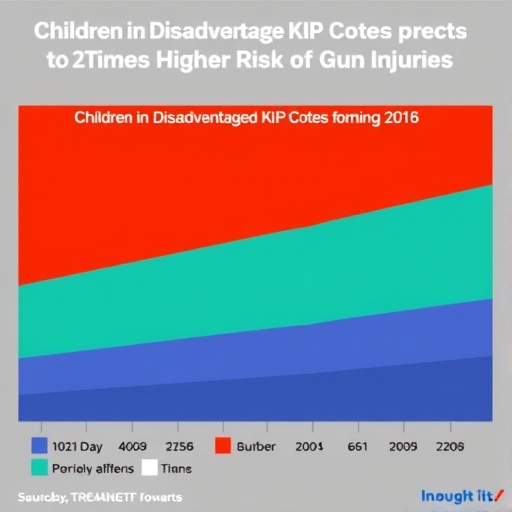
A groundbreaking multi-state study led by Northwestern Medicine has unveiled a stark and unsettling correlation between neighborhood conditions and pediatric firearm-related injuries. The research, which meticulously analyzed nearly 7,000 hospital discharge records of children aged 0 to 17, exposes how children residing in “very low-opportunity” neighborhoods face up to twenty times higher risk of hospitalization from gun injuries compared to their peers in the most affluent communities. This comprehensive investigation, soon to be published in the prestigious journal Pediatrics, sheds light on the urgent societal and healthcare challenges posed by pediatric firearm injuries and outlines critical implications for prevention and policy.
The study is distinguished by its novel integration of the Child Opportunity Index (COI), a robust metric that assigns ZIP codes a ranking from very low to very high opportunity based on key socioeconomic, educational, and health indicators. By overlaying pediatric hospital discharge data with COI rankings for four diverse states—Florida, Maryland, New York, and Wisconsin—the researchers precisely identified geographic hot spots where firearm injuries among children disproportionately cluster. This approach allowed a nuanced understanding of how structural inequalities at the neighborhood level deeply influence a child’s likelihood of sustaining a firearm injury requiring hospitalization.
Among the most striking discoveries is that more than a quarter of ZIP codes classified as very low-opportunity zones emerged as persistent hot spots for pediatric firearm injuries. In Maryland, for example, the disparity is most pronounced, with children living in disadvantaged neighborhoods over twenty times more likely to be hospitalized due to firearm injuries than those in the highest-opportunity areas. Wisconsin and New York also reflected stark disparities, with children in low-opportunity areas nearly sixteen and nineteen times more likely, respectively, to experience firearm hospitalizations. Florida showed a lower yet concerning eightfold increase. These findings lay bare the profound relationship between systemic socioeconomic deprivation and pediatric firearm trauma.
.adsslot_HYZmvAzQFe{width:728px !important;height:90px !important;}
@media(max-width:1199px){ .adsslot_HYZmvAzQFe{width:468px !important;height:60px !important;}
}
@media(max-width:767px){ .adsslot_HYZmvAzQFe{width:320px !important;height:50px !important;}
}
ADVERTISEMENT
Perhaps unexpectedly, the study reveals that while children in high-opportunity neighborhoods suffer fewer firearm injuries overall, their risk of mortality once injured is more than double that of children from low-opportunity areas. This counterintuitive finding appears linked to differences in the nature of firearm injuries, with self-inflicted injuries—often associated with greater lethality—being more prevalent in these privileged contexts. This dichotomy underscores the multifaceted nature of pediatric firearm injury epidemiology; interventions, therefore, must be tailored thoughtfully to address both environmental risks and individual behavioral factors.
A critical element of the analysis highlights the predominance of unintentional injuries as the leading cause of pediatric firearm hospitalizations across all studied states. Unintentional shootings, stemming from improper firearm handling, accidental discharges, or unsafe storage, accounted for approximately 57 to 63 percent of cases. Assault-related injuries constituted 32 to 39 percent, while self-inflicted injuries ranged from 1 to 7 percent. These statistics emphasize the urgent need for preventive measures focusing on firearm safety education and secure storage practices, especially in neighborhoods identified as hot spots.
The research team, led by trauma surgeons and public health experts at Northwestern, points out the practical implications for healthcare systems. Hospitals serving low-opportunity neighborhoods must anticipate and prepare for higher volumes of pediatric firearm injuries, necessitating resource allocation and trauma management protocols that reflect these epidemiological realities. Concurrently, the data offers a compelling call to policymakers and community leaders to prioritize targeted interventions in neighborhoods marked by concentrated disadvantage.
Extant literature corroborates the effectiveness of Child Access Prevention (CAP) laws—legislation requiring safe firearm storage—in mitigating accidental and suicide-related deaths among children. This study’s findings reinforce the vital role of such legislation and suggest further research is needed to quantify how enforcement intensity and educational outreach can amplify reductions in unintentional firearm injuries. The researchers advocate for integrated, multi-level strategies that combine community engagement, policy enactment, and clinical vigilance to mitigate this ongoing public health crisis.
Importantly, this study acknowledges inherent limitations. It draws exclusively on hospital discharge data, thereby excluding children who succumb to firearm injuries before hospital arrival or those who avoid medical care altogether. Consequently, while the findings accurately reflect hospitalization patterns, they likely underrepresent the true scope of firearm-related harm to children, calling for complementary research methodologies to capture the full epidemiologic landscape.
From a methodological perspective, the rigorous use of the Child Opportunity Index as a proxy for neighborhood advantage lends the study high external validity and policy relevance. Contrasting hospital encounter data across well-defined socioeconomic strata permits actionable insights into structural determinants of pediatric gun violence. The multi-state design further enhances generalizability, moving beyond regionally limited studies to frame firearm injuries within broader social and ecological contexts.
Pediatric firearm injuries have been the leading cause of death for U.S. children for several years, a tragic status highlighted within the study and supported by national mortality data. While homicide and suicide among youth remain deeply concerning, the study’s emphasis on unintentional firearm injuries exposes critical prevention gaps often overshadowed in public discourse. By quantifying these injuries in relation to neighborhood opportunity, the research elucidates hidden intersections of poverty, environment, and public health risk.
This study’s timely and sobering revelations arrive amid a broader national crisis of firearm violence and pediatric mortality in the United States. It advances the public health imperative to not only improve trauma care but also to synergize upstream preventive efforts tackling social determinants of health. Ultimately, the research underscores that addressing pediatric firearm injuries demands multidisciplinary collaboration spanning medicine, law enforcement, education, and community development.
As the publication date approaches, the researchers plan to expand their analyses, including investigating the effectiveness of firearm safety programs and legislative measures in reducing unintentional injuries within identified hot spots. Their ongoing work promises to inform evidence-based policies, guiding interventions that safeguard vulnerable children and reduce disparities rooted in neighborhood opportunity. By uniting rigorous data analysis with compassionate advocacy, this study aims to catalyze concerted action toward healthier, safer communities for all children.
Subject of Research: Pediatric firearm-related hospital encounters correlated with neighborhood opportunity levels
Article Title: Pediatric Firearm-Related Hospital Encounters by Child Opportunity Index Level
News Publication Date: 25-Aug-2025
Web References:
Child Opportunity Index data: https://www.diversitydatakids.org/download-child-opportunity-index-data
U.S. gun deaths and firearm suicide report: https://publichealth.jhu.edu/2025/new-report-highlights-us-2023-gun-deaths-suicide-by-firearm-at-record-levels-for-third-straight-year
Keywords: Gun violence, Firearms, Pediatrics
Tags: Child Opportunity Index analysischildren and gun injuriesfirearm injury prevention strategieshospital discharge records studyimplications for public health policymulti-state health researchneighborhood disparities in healthcarepediatric firearm-related injuriespediatric healthcare challengessocioeconomic factors and health outcomesstructural inequalities in healthurban health disparities





